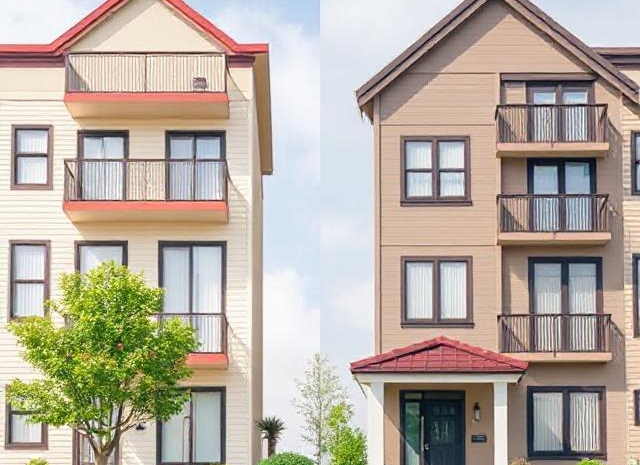
Home Insurance For Condos Vs. Houses: Key Differences
When deciding between home insurance for condos versus houses, it’s important to understand the key differences in coverage, needs, and policies. Here’s a breakdown to help you navigate the differences:
1. Coverage for the Structure
- Condo Insurance (HO-6):
- Condo insurance generally covers the interior of your individual unit, including walls, floors, ceilings, personal property, and any upgrades you’ve made to the unit (e.g., cabinetry, appliances, or fixtures).
- The building’s exterior (such as the walls, roof, and shared spaces) is typically covered by the condo association’s master policy.
- Home Insurance (HO-3):
- In a standalone house, home insurance covers the entire structure of the home, including the roof, walls, floors, and foundation. It also covers detached structures like a garage or shed.
- Homeowners are responsible for both the interior and exterior of the property.
2. Master Policy vs. Personal Policy
- Condo Insurance:
- The condo association usually has a master policy that covers the common areas of the property (e.g., hallways, lobby, elevators, swimming pools, and exterior). You’ll need to review this policy to understand what is and isn’t covered.
- The personal condo policy (HO-6) will fill in the gaps for your unit’s interior, personal belongings, and liability coverage. It’s essential to know what the condo association’s policy covers to avoid overlapping or missing coverage.
- Home Insurance:
- Homeowners have no master policy, as they own both the interior and exterior of their property. Home insurance will cover everything from the structure to personal property and liability on the entire premises.
3. Personal Property Coverage
- Condo Insurance:
- Personal property coverage in condo insurance protects your belongings inside the unit, such as furniture, clothing, electronics, and other valuables. This coverage doesn’t extend to the exterior or common areas, as those are managed by the condo association.
- Home Insurance:
- Similarly, home insurance covers personal belongings inside the house. However, it also includes things like yard furniture, garden tools, and other outdoor items, provided they’re located on the insured property.
4. Liability Coverage
- Condo Insurance:
- Condo insurance includes liability protection for accidents that occur within your unit (e.g., a guest slips and falls inside your home). However, it typically doesn’t cover incidents that occur in shared spaces like hallways or parking lots.
- Home Insurance:
- Home insurance provides liability coverage for accidents that happen anywhere on your property, including the house and the yard. It also extends to situations where you or a family member are legally responsible for injury or damage to others outside your home.
5. Cost
- Condo Insurance:
- Condo insurance tends to be less expensive than home insurance because you’re only insuring the interior of your unit, not the entire building or the exterior.
- The cost is also impacted by the location of the condo, the building’s construction, and the level of coverage you choose.
- Home Insurance:
- Home insurance premiums are generally higher because you are covering the entire structure of the house, including its foundation, roof, and any other exterior structures like a garage or a fence.
6. Flood and Earthquake Coverage
- Condo Insurance:
- Condo insurance usually doesn’t cover natural disasters like floods or earthquakes. You may need to purchase separate coverage for these risks, depending on the location of your condo.
- Home Insurance:
- Similarly, standard home insurance does not typically cover floods or earthquakes. Homeowners will need to add a separate flood or earthquake policy if they live in an area prone to these hazards.
7. HOA Fees and Condo Association Coverage
- Condo Insurance:
- You will likely pay monthly or quarterly fees to the condo association (HOA), which helps maintain common areas and covers certain structural elements. Understanding what’s included in the HOA fees is crucial, as it may impact the level of personal coverage you need.
- Condo association policies usually cover exterior elements of the building, common areas, and sometimes even basic building systems (e.g., plumbing and electrical).
- Home Insurance:
- There’s no HOA fee for homeowners since you’re responsible for maintaining and insuring your entire property yourself. Everything on your property, inside and outside, is your responsibility for both upkeep and insurance.
8. Coverage for Common Areas and Shared Spaces
- Condo Insurance:
- The condo association’s master policy usually handles coverage for shared spaces like hallways, elevators, parking garages, pools, or landscaping. Your individual policy will cover only your private unit’s interior and any personal belongings inside.
- Home Insurance:
- Homeowners are responsible for all areas of their property, including the yard, driveway, and any detached structures. There’s no need for a master policy since you own the entire property.
9. Deductibles
- Condo Insurance:
- Condo owners may have to pay a deductible for damage within their unit, as well as a deductible for damages in the shared areas, depending on the terms of the condo association’s master policy.
- Home Insurance:
- Homeowners typically pay a single deductible for damages to the house, yard, and any outbuildings. The amount can vary depending on the level of coverage selected.
10. Renovation and Upgrades
- Condo Insurance:
- When making upgrades to your condo (like installing a new kitchen or bathroom), be sure to adjust your insurance policy to reflect the increased value. However, the condo association’s policy will usually cover only the shared or external areas.
- Home Insurance:
- Homeowners need to regularly update their policy when they renovate or upgrade their home to ensure the increased value is covered.

